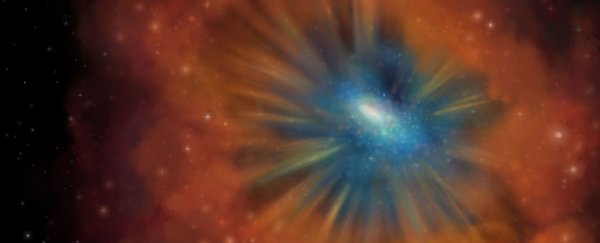The beginning of the end of our galaxy is just a few billion years away. That's when the glittering disk of the Milky Way is projected to smash into its nearest neighbor, a spiral galaxy called Andromeda.
The force of the collision will fuse the black holes at the centers of the galaxies, producing a luminous whirlpool of fast-moving, ultrahot gas known as a quasar.
Far from the galactic center, on a remote and unimportant planet called Earth, the quasar will initially appear as a brilliant blue halo in the sky, so bright it outshines the stars.
But quasars are prone to cataclysmic flashes, which sweep gas and dust - the stuff that suns and worlds and life are made of - straight out into the circumgalactic medium. Eventually, the galaxy will empty itself of the material for making new stars.
This is how all galaxies die - at least, according to the theories. But until now, no one has captured a galaxy in its transition phase, after the formation of a quasar but before it has lost all its stellar building blocks.
In research presented Wednesday at the annual meeting of the American Astronomical Society in St. Louis, astrophysicist Allison Kirkpatrick announced the detection of 22 objects she calls "cold quasars".
These distant bodies glow bright enough to be beginning their death throes, Kirkpatrick said, but still contain cool clouds of dust, suggesting they have not yet lost the ability to birth new stars.
They are right on the brink - hovering between the epoch of creation and the eon of waiting for death.
"One of the biggest questions we have in astronomy is: How do galaxies die?" said Kirkpatrick, an assistant professor at the University of Kansas. "We know what they look like once they're dead . . . but the rest of it is just pieces that we've guessed at."
Now, she continued, "we've found a population that we can study in detail and map out exactly how these galaxies move from their star formation phase of their life to their retirement phase."
The discovery came during a survey of the brightest objects in the sky. Most such surveys examine X-rays produced by gas swooshing toward a black hole at close to the speed of light - exactly the kind of high-energy radiation you would associate with a monstrously massive quasar.
But Kirkpatrick also looked at these objects using infrared light, which emanates from much cooler phenomena, farther from galaxies' violent cores.
"Infrared detections . . . suggest very, very cold dust. That's not something you typically expect to see," Kirkpatrick said.
Her next step will be to attempt to measure the speed at which gas and dust are being blown out of the galaxy, which will let Kirkpatrick calculate how long galaxies spend in the "cold quasar" phase.
She will continue to seek more of these objects, which offer a glimpse into a little-understood phase of galactic histories.
"Astronomy is a unique science in that it's passive," she said. "We can't watch any process in real time, so we are limited by snapshots of different galaxies we try to link together."
"The more we can fill in that picture with snapshots, the better we can tell this story," she said. "And I think I found a new snapshot."
2019 © The Washington Post
This article was originally published by The Washington Post.
